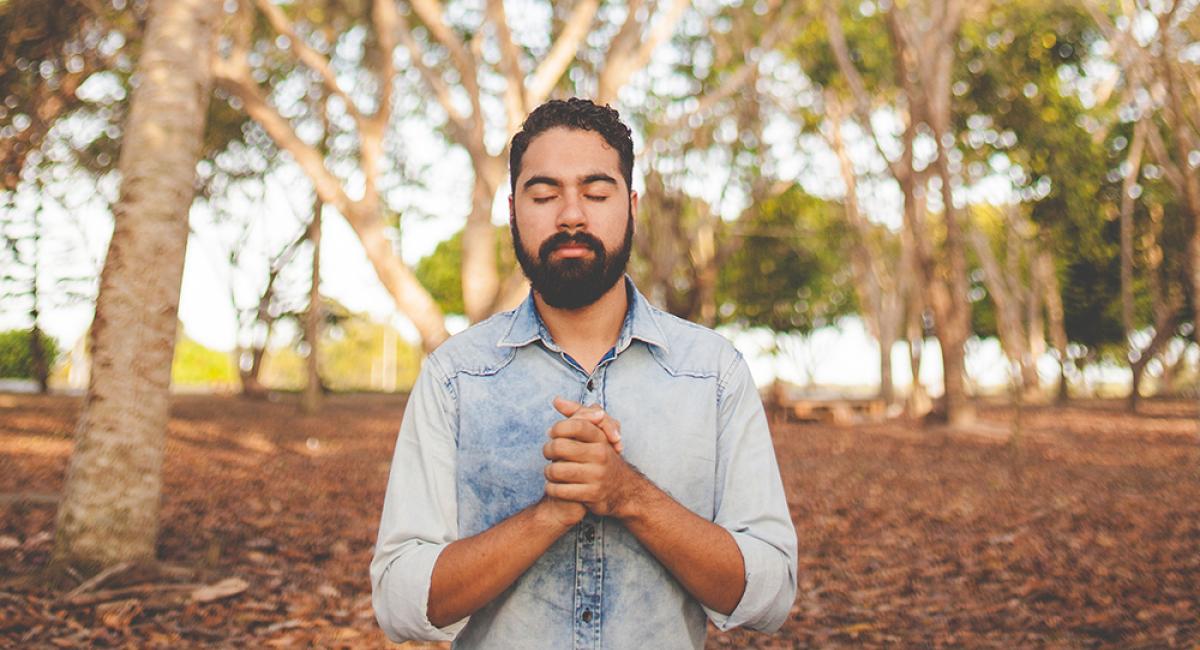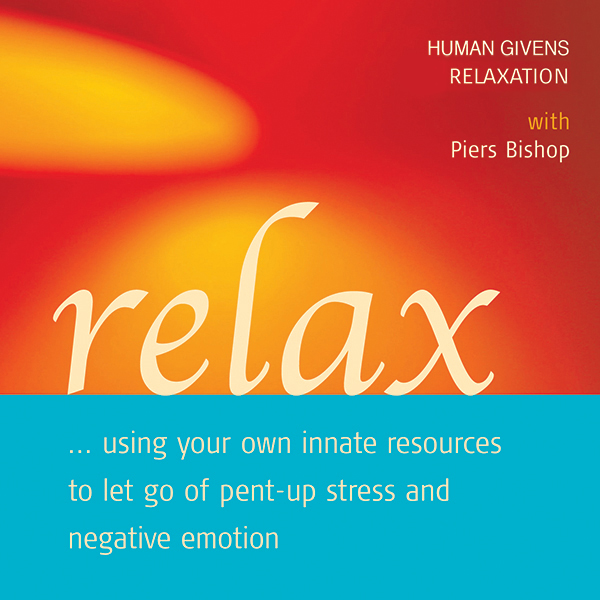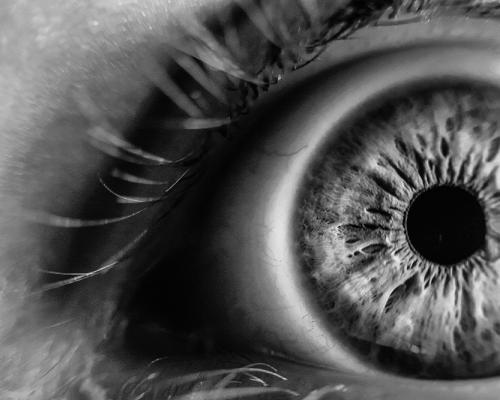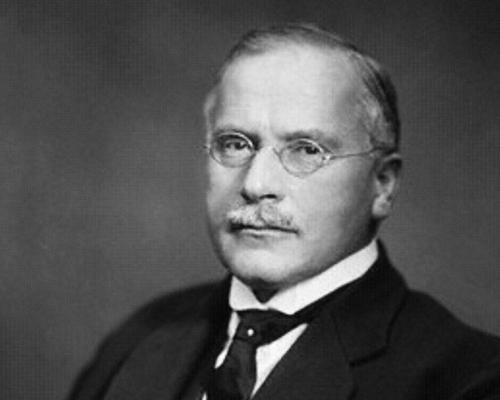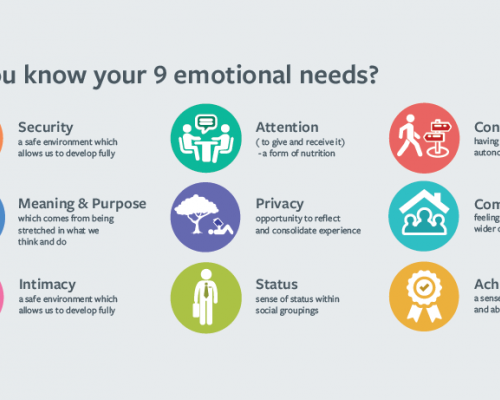“Use the breath. It’s easier”
Sam Gerrard explores the benefits of 7:11 breathing and shares the results of his own and others’ research into the technique
"When the mind cannot control the mind, use the breath. It’s easier.” These are the simple but powerful words of Sri Sri Ravi Shankar, spiritual leader and founder of the Art of Living Foundation, based in Bangalore, one of the world’s largest humanitarian non-governmental organisations. For thousands of years, Eastern cultures have understood the powerful effects that breathing can have on our health, wellbeing and spiritual growth, developing highly sophisticated breathing practices to access its transformative potential. However, in the West, such techniques are less well known, understood or valued.
Despite my own training in relaxation and meditation techniques, it wasn’t until I witnessed firsthand just how beneficial even a simple breathing technique can be that I fully appreciated the extent of the power of the breath and subsequently went on to research how its therapeutic effects could be maximised.
Peter, a 63-year-old electrician, sought my help not as a human givens therapist but as a trained meditation teacher. He had been suffering with severe anxiety symptoms for just over a year but made it clear that he did not wish to pursue further psychotherapy, as he felt that he had tried this approach with several other counsellors and psychiatrists to no avail. I, therefore, simply explained to Peter that, in his case, the sympathetic nervous system, which mediates stress, was probably being over stimulated, resulting in the fight-or-flight symptoms of panic that he described.
He seemed to enjoy learning about the mechanics of the nervous system and was “willing to try anything” to calm his body down. He was, therefore, keen to learn the 7:11 breathing technique, which all human givens practitioners are taught to use. It involves breathing diaphragmatically, to a count of 7 on the inhalation and 11 on the exhalation. Within minutes of starting to practise it, Peter seemed more calm and was delighted to have been given a practical tool that offered such immediate relief. I also invited him to attend a mindfulness, relaxation and meditation class, which I ran weekly. Peter relished coming to this and he soon became a dedicated practitioner, performing mindfulness and breathing exercises routinely every day and especially when his anxiety symptoms were most acute. He said to me, “Despite all the medication, doctors, psychiatrists, counsellors and healers, the only thing that has really helped is the breathing exercises.” His words made a lasting impression on me. Never again would I underestimate the importance of teaching someone such a simple breathing technique. This gave me the impetus to study its healing potential as part of my human givens Master’s degree research project.
The mechanics of healthy breathing
Before exploring the evidence and theories related specifically to the 7:11 breathing technique, I shall recap some of the psycho-physiological mechanisms that make the breath such a powerful regulator of physical, emotional and psychological wellbeing. One such mechanism is the bi-directional influence that exists between respiration and the activation of the parasympathetic and sympathetic divisions of the autonomic nervous system. The sympathetic nervous system primes the body for action. Inhaling activates this system, increasing heart rate, blood flow, respiration rate and blood pressure; in heightened states of arousal, the sympathetic response can release adrenalin and cortisol. Exhaling activates the parasympathetic nervous system, which decreases respiration rate and mediates relaxing and restorative functions, such as energy storage, growth, digestion and other processes. Our breathing rate also plays a vital role in stimulating aspects of the nervous system. For example, breathing rapidly can mediate more of an overall sympathetic response, while breathing slowly and deeply mediates a shift towards a parasympathetic response.
This relationship between breath and the nervous system also works in the opposite direction. As we know from personal experience, our breathing rate slows down in a relaxing situation; while, in a threatening situation, it speeds up. Although there are times when stress and the activation of the sympathetic nervous system play a vital role in protecting and motivating the human organism, this primitive, instinctual intelligence can become over-stimulated in the fast pace of modern Western living, where ‘threats’ are rarely directly life threatening. In these circumstances, respiration rate and the associated arousal can stay high. The average person’s breathing rate is reported to be between 12 and 16 breaths per minute, whereas many breath trainers recommend 4 to 6 breaths per minute as an optimum rate. In cases of acute anxiety, breathing rate can be as high as 18 breaths per minute.1 Living in such a heightened state of sympathetic arousal can encourage physical disorders (as free radicals are released, vital energy burned up and inflammatory processes increase) and psychological and emotional difficulties, such as feelings of exhaustion, helplessness and over-activity of the mind – all of which, from a human givens perspective, may be related to depression, anxiety and other common psychopathologies.
Evidence of this bi-directional relationship between respiration rate and sympathetic arousal can be seen particularly clearly in asthma, which is commonly characterised by restricted fast and shallow breathing in the upper part of the chest. One large-scale meta-analysis, which looked at studies involving 85,000 people across 17 countries, found reports of anxiety-related disorders were 50 per cent higher in asthma sufferers than in those who did not suffer asthma.2 Another study showed that psychosocial difficulties were involved in both the development and the prognosis of asthma.3 With the aid of breath training techniques, such as those developed by Dr Buteyko in the 1950s4,5,6 and of biofeedback trainers in the last decade,7 many asthma patients have been able to find some relief from symptoms or reduce medication intake just by learning to breathe more optimally. Of course, it is not just asthma sufferers that can benefit from breath training; so can anyone who has symptoms related to heightened sympathetic arousal.
Effects on the heart rate
The breath has been described as being both the “thermometer” and the “thermostat” of the autonomic nervous system.8 Fortunately, we have the innate ability to sense and control respiration rate consciously – thus giving us a means to influence this normally involuntary activity. One way in which researchers have measured the efficacy of breathing techniques in reducing arousal is by analysis of their effects on the heartbeat. While most of us are aware that the heart rate is faster when we are stressed and slower when we are relaxed, it is less well known that within each breath cycle there are subtle variations in the rate. As explained, on inhaling, the sympathetic nervous system causes acceleration in heart rate and, on exhaling, the parasympathetic branch causes its deceleration. This acceleration and deceleration in synchrony with respiration is known as respiratory sinus arrhythmia. The degree to which this heart rate frequency varies from beat to beat is measured as heart rate variability (HRV). So, for example, when we are relaxed and exhale slowly, the heart rate will become slower than when we are breathing in, thereby creating variability in the heart rate. When variability in heart rate is low, it indicates a sympathetic emphasis and when it is higher it indicates parasympathetic emphasis, or a greater balance between the two.
Extremely low HRV has been reported to correlate with elevated risk of sudden cardiac death, coronary heart disease and mortality, and is therefore used in clinical settings as a reliable test for detecting a range of autonomic disorders.9 In one recently published study, a link between low HRV and major depressive disorders was also reported.10 HRV was especially low in those who had generalised anxiety disorders as well. Connections have also been reported between low HRV and stress, anxiety, panic disorder, depression, post-traumatic stress disorder, attention deficit disorder and excess aggression.11,12,13,14,15 Conversely, higher HRV has been linked with a more resilient stress response system, healthier cardiovascular system, and clarity of mind.16,17 High or well-balanced HRV is, therefore, sometimes viewed as an indicator of overall wellbeing.
Diaphragmatic breathing
Deep diaphragmatic breathing techniques can maximise HRV and its potentially positive effects. When we breathe at a rate of between four and a half and six breaths per minute, efficiency of the cardiopulmonary system is thought to be optimised, as various rhythmic functions appear to stimulate, or resonate with, one another.18 This breathing rate, known as the resonant frequency, is used in many biofeedback-based breath-retraining protocols.
As well as helping people to breathe closer to resonant frequency, some biofeedback trainers and health professionals, including human givens practitioners, recommend an extended or prolonged exhalation. American psychiatrists, breath trainers and researchers Dr Robert Brown and Dr Patricia Gerbarg suggest that, “When the outbreath is longer than the in-breath, there is greater stimulation of the parasympathetic system and the effect is mentally calming and physically relaxing”. 16 In one of the most authoritative manuals used for resonant frequency biofeedback training, an extended exhalation is used as part of the protocol.19 Several studies have demonstrated its significant therapeutic benefits in treating a range of health problems such as hypertension,20 asthma,7depression,21 fibromyalgia22 and heart disease.23
What the literature shows
Whilst it may be true that exhalation is predominantly characterised by parasympathetic activity, there is little evidence that excessively prolonging the exhalation, or continuing this practice over an extended time-span, is more beneficial. In fact, some researchers suggest that maximum HRV and resonant frequency is best achieved through the use of an equal ratio breath.8 Study findings have been mixed, with some finding no, or only marginal, differences in HRV between equal ratio and extended exhalation breathing24,25 and some finding extended exhalation ratio superior at increasing HRV26 and in lowering other measures of sympathetic response27 – particularly when under threat.28
For me, it was not surprising to discover that current research findings do not provide any definitive answers on how effective extended exhalation breathing can be. As I found out for myself, developing a study design that gives accurate measurements and interpretations is no easy task. My own study compared perceived relaxation reports and quantitative heart rate variability data. One difficult decision I had to make was whether or not to control participants’ respiration rate as they performed two breathing exercises, one with equal ratio and the other with the extended exhalation. If I chose to control respiration rate, it would not allow people to slow down their breathing naturally, as they became more relaxed during the exercise. However, as respiration rate is known to alter HRV, I felt I had to control it, otherwise the study would not have isolated the ratio as being the cause of any differences found in the results. This was just one of a few difficulties I found in striking a balance between rigorous methodology and allowing for the breathing exercises to be carried out in a fashion closer to how they would be used in a natural therapeutic setting. However, I believe the results are still valuable.
Study results
Thirty men and women, aged 31 to 77 and with no diagnosed breathing difficulties or psychopathologies, were invited to take part in my study and each attended an individual meeting with me. Before starting the breathing exercises, I asked participants to lie back in a reclining chair and to practise deep and slow diaphragmatic breathing. Once they had settled into a breathing rate that felt relaxing to them, I set my computer breathing pacer to that rate. They were then asked to follow the pacer as it guided them through two 10-minute breathing exercises – one with equal ratio of 9:9 and the other with an extended exhalation to the ratio of 7:11. As the participants synchronised their breathing with the pacer’s ratio and rate, their heart beats were recorded via an electrode clipped to their ear lobe – I analysed these later, using specialist HRV software. Afterwards, I conducted a semi-structured interview on their experience of the two breathing ratios.
Sixteen participants perceived the extended exhalation ratio (7:11) as more relaxing and 14 perceived the equal ratio (9:9) more relaxing. The HRV data were inconclusive and therefore did not suggest either technique was significantly more effective. Since the results were so divided, this raises the question of what works best for whom and why. This I believe can be best answered through study of the participants’ interview transcripts.
Many participants had strong preferences for one breathing ratio over the other. One of the primary reasons given by participants for their chosen preference was what felt most “natural”. Although it is recognised that learning any new skill or technique may feel a little unnatural at first and take some time to master, participants reported having anxious feelings and thoughts during the breathing exercise if it differed too much from their usual breathing pattern.
When, prior to the exercises, I recorded participants’ usual in-breath and out-breath times, I had noted that some people routinely inhaled for longer than they exhaled, so, for them, it might have been particularly challenging to use a ratio with a longer exhalation than inhalation. I now encourage any client who faces this challenge to lengthen the exhalation progressively towards equal ratio and eventually towards a longer exhalation with time. I also suggest the following simple technique, which I have found to be effective. Clients put a finger just under their noses and feel the sensation of the air they exhale hitting their finger. Then I ask them to begin exhaling more gently, so that the sensation of air on the finger reduces. This naturally lengthens the exhalation and slows down the overall respiration rate. Another technique is to ask clients to breathe in through the nose and out through pursed lips – imagining that they are blowing air very gently through a straw.
Participants told me they also felt uncomfortable if the respiration rate or ratio caused them to over-exert themselves physically. To avoid strain from breathing too deeply or forcefully, breath trainers often encourage practitioners to pay attention to the sensation of inhaling, so that they can monitor at what point the lungs begin to feel uncomfortably over-full with air. There is typically a point between 70–80 per cent of lung capacity where strain can begin to be observed, on both the inhale and end of exhale. I encourage clients to breathe within this 70–80 per cent window, as there is little point in breathing deeply if it is not going to be relaxing. It also reduces the chances of hyperventilation, which can occur when people first begin to learn deep diaphragmatic breathing techniques.18
A few participants said that they would have felt more relaxed if they could have paused between the exhale and inhale. Some breath trainers strongly recommend a pause, seeing it as a moment that enables the nervous system to rest in a state of neutrality. Some yoga and meditation schools view a brief pause after exhalation as a means of connecting with one’s sense of inner stillness – or, from a human givens perspective, the ‘observing self’ – which is thought to be therapeutic.29
Getting creative
I find it really helps if I am creative with the delivery of breath training to clients. For example, if clients cannot bear to sit still and practise for several minutes, I find it useful to show them simple rhythmic Chi Kung movements. The picture shows the first exercise in a sequence of 18 Tai Chi–Chi Kung movements, which are sometimes referred to as Shibashi. The movements are very simple to learn and have been used in many Chinese medical studies. Each flowing movement is synchronised with slow deep breathing, making the sequence ideal for calming the nervous system.
The movement begins with the person in an upright standing position, feet shoulder width apart, arms relaxed by the sides and knees bent. As they begin to breathe in, they raise their arms slowly in front of the body (as if the arms are being lifted up from the wrists like a puppet on strings) and begin to straighten their knees a little. The arms should remain as relaxed as possible during the movement and the breath should be synchronised with the movement, inhaling to a count of 7. Once the arms reach about shoulder level and the inhalation is complete, the person begins to lower their arms slowly back down and bend the knees again, exhaling to the count of 11. The movement can be repeated as many times as thought helpful, the emphasis each time on maintaining a sense of flowing movement and mindfulness of the bodily sensations.
I find that, once clients begin to relax through these movements, they are often more prepared to try the breathing while sitting still. Also, encouraging clients to find a creative metaphor for the breathing can be useful. One participant in my study said to me that the exhale “feels like I’m rolling down a hill”; another called the exhale a “releasing breath”. Both found that these images helped them to focus. Once clients have mastered the basics of the 7:11 technique, I often encourage them to cultivate positive emotions by imagining inhaling feelings of peace or joy into the heart, or perhaps exhaling negative feelings such as frustration or anger. Such techniques have been demonstrated to increase HRV.30
Why 7:11 works
While my research showed that both equal ratio breathing and extended exhalation breathing can be of benefit, there are some possible additional advantages to using the extended exhalation. For example, two participants said that, while using the 7:11 technique, they found that they wanted to slow down their breathing rate. This effect of slowing respiration rate through extending the exhalation can also be achieved by using hand held breathing pacers, which are sold as aids to reduce blood pressure.31 It could perhaps be one of the primary therapeutic mechanisms of the 7:11 technique. As one person commented, the extended exhalation caused her lungs to completely empty of air, therefore making the full capacity of the lungs available for a fuller inhale. A fuller and deeper in-breath draws in more oxygen and therefore the respiration rate can decrease. Any component of a breathing technique that encourages slower respiration is beneficial, whether that is breathing diaphragmatically to use the full capacity of the lungs, or through nostril or pursed lip breathing, which naturally restricts the flow rate of air compared with breathing through an open mouth. The respiration rate is brought closer to a frequency where HRV and parasympathetic activity can increase, and emotional arousal decrease.
Finally, the study showed that the 7:11 technique can help people’s concentration and bring their attention into the present moment – especially as the extended exhalation is, for most people, a new skill which requires additional focus. As one participant commented, “My brain wasn’t going off at tangents thinking about all the things I had on my mind before I came here. I was just in a completely relaxed state, enjoying the tranquillity, enjoying the peace.” Being in the present moment, one of the main benefits of mindfulness techniques, reduces the tendency to dwell on difficulties faced in the past or catastrophise about future challenges – both of which, as we know, can lead to emotional arousal and, ultimately, higher risks of anxiety and depression.
Here in the West, we are still in our infancy in terms of understanding the power of the breath and much research needs to be done before we can harness its full potential. Nonetheless we can be confident that, when taught correctly, any deep diaphragmatic breathing technique such as 7:11 has inestimable therapeutic benefits.
Sam Gerrard has a Masters degree in human givens psychotherapy. He is also a qualified teacher of meditation, mindfulness and Qigong, working with clients privately and holding weekly public classes in Merseyside. As part of his continued professional development Sam is currently studying various forms of breath training and biofeedback techniques.
This article first appeared in the "Human Givens Journal" Volume 20 - No. 1: 2013
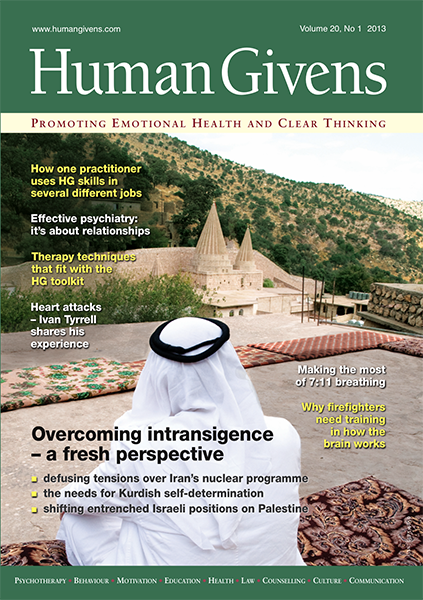 Spread the word – each issue of the Journal is jam-packed with thought-provoking articles, interviews, case histories, news, research findings, book reviews and more. The journal takes no advertising at all, in order to maintain its editorial independence.
Spread the word – each issue of the Journal is jam-packed with thought-provoking articles, interviews, case histories, news, research findings, book reviews and more. The journal takes no advertising at all, in order to maintain its editorial independence.
To survive, however, it needs new readers and subscribers – if you find the articles, case histories and interviews on this website helpful, and would like to support the human givens approach – please take out a subscription or buy a back issue today.
REFERENCES
- Fried, R and Grimaldi, J (1993). The Physiology and Psychology of Breathing in Behavioral Medicine, Clinical Psychology, and Psychiatry. Plenum Press, New York.
- Scott, K M, Von Korff, M et al (2007). Mental disorders among adults with asthma: results from the World Mental Health Survey. General Hospital Psychiatry, 29, 123–33.
- Chida, Y, Hamer, M and Steptoe, A (2008). A bidirectional relationship between psychosocial factors and atopic disorders. Psychosomatic Medicine, 70,1, 102–16.
- McHugh, P, Duncan, B et al (2006). Buteyko breathing technique and asthma in children. New Zealand Medical Journal, 119, 1234, 8716–19.
- Bowler, S, Green, A et al (1998). Buteyko breathing techniques in asthma. Medical Journal of Australia, 169, 11, 575–8.
- Cowie, R, Conley, D et al (2008). A randomised controlled trial of the Buteyko technique as an adjunct to conventional management of asthma Respir. Medicine, 102, 5, 726–32.
- Lehrer, P, Vaschillo, E et al (2004). Biofeedback as a treatment for asthma. Chest, 126, 352–61.
- Elliot, S and Edmonson, D (2008). Coherent Breathing. Coherence Press, Allen.
- Shields, R (2009). Heart rate variability with deep breathing as a clinical test of cardiovagal function. Cleveland Clinic Journal of Medicine. 76, S37–40.
- Kemp, A, Quintana, D et al (2012). Depression, comorbid anxiety disorders, and heart rate variability in physically healthy, unmedicated patients. PLoS ONE [e-journal] 7, 2.
- Brown, R and Gerbarg, P (2005). Sudarshan Kriya yogic breathing in the treatment of stress, anxiety and depression. Journal of Alternative and Complementary Medicine, 11, 1, 189– 201.
- Friedman, B and Thayer, J (1998). Autonomic balance revisited. Journal of Psychosomatic Research, 44, 133–151.
- Haug, T, Svebak, S, et al (1994). Low vagal activity as mediating mechanism for the relationship between personality factors and gastric symptoms in functional dyspepsia. Psychosomatic Medicine, 56, 181–86.
- Beauchaine, T (2001). Vagal tone, development, and Gray’s motivational theory. Developmental Psychopathology, 13, 2, 183–214.
- Porges, S (2001). The polyvagal theory. International Journal of Psychophysiology, 42, 2, 123–46.
- Brown, R and Gerbarg, P (2012). The Healing Power of the Breath. Shambhala, Boston.
- Porges S (1992). Autonomic regulation and attention. In B Campbell, H Hayne and R Richardson (eds) Attention and information processing in infants and adults. Lawrence Erlbaum Associates, Hillsdale, NJ.
- Evgeny, G, Vaschillo, E et al (2006). Characteristics of resonance in heart rate variability stimulated biofeedback. Applied Psychophysiology and Biofeedback, 31, 2, 129–42.
- Lehrer, P M, Vaschillo, E and Vaschillo, B (2000). Resonant frequency biofeedback training to increase cardiac variability. Applied Psychophysiology and Biofeedback, 25, 177–91.
- Del Pozo, J, Gevirtz, R et al (2004). Biofeedback treatment increases heart rate variability in patients with known coronary artery disease. American Heart Journal, 147, E11.
- Karavidas, M K, Lehrer, P et al (2007). Preliminary results of an open-label study of heart rate variability biofeedback for the treatment of major depression. Applied Psychophysiology and Biofeedback, 32, 19–30.
- Hassett, A, Radvanski, D et al (2007). A pilot study of the efficacy of HRV biofeedback in patients with fibromyalgia. Applied Psychophysiology and Biofeedback, 32, 1, 1–10.
- Cowan, M J, Pike, K C and Budzynski, HK (2001). Psychosocial nursing therapy following sudden cardiac arrest: impact on two year survival. Nursing Research, 50, 68–76.
- Edmonds, W A, Kennedy, T et al (2009). A single-participants investigation of the effects of various biofeedback-assisted breathing patterns on heart rate variability. cBiofeedback, 37, 4, 141– 6.
- Rowe, J (1997). Effect of inspiration to expiration ratio on automatic arousal. PhD. University of Missouri-Columbia.
- Strauss-Blasche, G, Moser et al (2000). Relative timing of inspiration and expiration affects respiratory sinus arrhythmia. Clinical and Experimental Pharmacology and Physiology, 27, 8, 601–6.
- Montserrat, C P, Javier Menendez, F, et al (2008). The influence of respiration on biofeedback techniques. Applied Psychophysiology and Biofeedback, 33, 49–54.
- Cappo, B M and Holmes, D S (1984). The utility of prolonged respiratory expiration for reducing physiological and psychological arousal in non-threatening and threatening situations. Journal of Psychosomatic Research, 28, 265–73.
- Deikman, A J (1992). The Observing Self: mysticism and psychotherapy. Beacon Press, Boston.
- Tiller, W A, McCraty, R and Atkinson, M (1996). Cardiac coherence: a new, non-invasive measure of autonomic nervous system order. Alternative Therapies, 2, 1, 52–65.
- Schein, M, Gavish, B et al (2001). Treating hypertension with a device that slows and regularises breathing. Journal of Human Hypertension, 15, 4, 271– 8.
Latest Tweets:
Tweets by humangivensLatest News:
SCoPEd - latest update
The six SCoPEd partners have published their latest update on the important work currently underway with regards to the SCoPEd framework implementation, governance and impact assessment.
Date posted: 14/02/2024
2024 Conference
Our next in-person HGI Conference, is being held on the weekend of 20th and 21st April 2024




